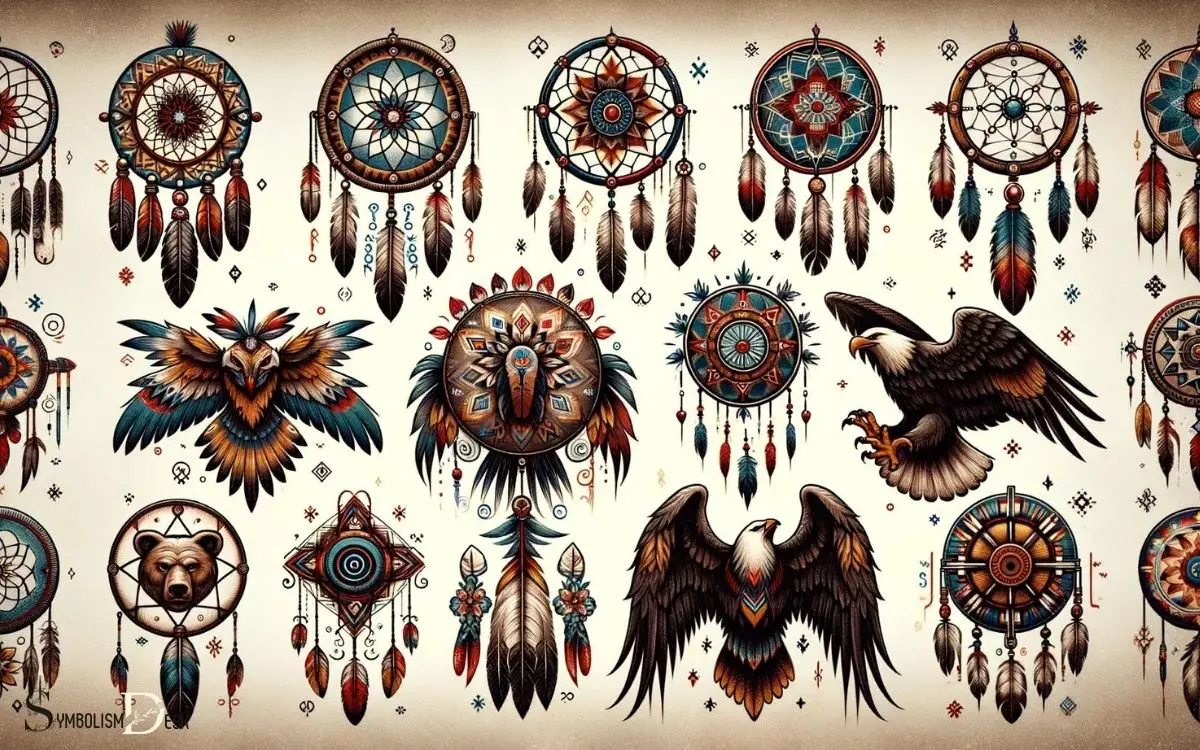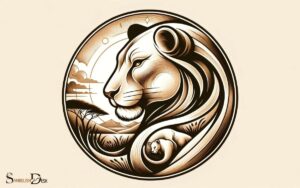Native American Tattoo Symbols and Meanings: Strength!
Native American tattoo symbols embody rich meanings, deeply rooted in the spiritual and cultural life of indigenous people.
These tattoos often symbolize a connection to nature, animals, and the spiritual world. Popular symbols include the eagle, representing strength and freedom; the dreamcatcher, for protection; and the bear, a symbol of courage and physical power.
When considering a Native American tattoo, it’s important to understand the specific tribal origins and meanings to honor the culture respectfully.
Native American tattoos serve as more than mere body art; they are a testament to the wearer’s identity, heritage, and beliefs.
Each symbol is a visual narrative of tribal affiliation, personal achievements, spiritual or shamanic connections, and stories and traditions passed down through generations.
For example, a wolf symbol may represent loyalty and family, while a feather might symbolize trust, honor, and strength.
Choosing a Native American tattoo requires cultural sensitivity and an appreciation for the profound heritage it represents.

Key Takeaway
Origins of Native American Tattooing
The origins of Native American tattooing can be traced back to the ancient traditions of various indigenous tribes across North and South America.
For these tribes, tattoos held deep cultural and spiritual significance. They were used to symbolize one’s connection to the tribe, their achievements, and their spiritual beliefs.
Each tribe had its own distinct tattooing practices and designs, often reflecting elements of nature, such as animals, plants, and celestial bodies.
These tattoos weren’t just decorative; they were a way of expressing identity and belonging within the community.
The intricate patterns and symbols used in these tattoos were passed down through generations, preserving the rich heritage of the Native American tribes. This deep-rooted tradition of tattooing continues to influence modern tattoo art and culture today.
Moving forward, it’s essential to delve into the symbolism of animal spirits within Native American tattooing.
Symbolism of Animal Spirits
Animal spirits hold significant symbolism in Native American tattoo art, representing various traits and characteristics valued by different tribes.
The bear, for instance, symbolizes strength, courage, and healing, and is often associated with protection and leadership in many Native American cultures.
The wolf embodies intelligence, loyalty, and strong family ties, reflecting the importance of community and unity. The eagle is revered for its connection to the divine, symbolizing vision, wisdom, and spiritual power.
Other animals like the turtle, deer, and buffalo also carry deep symbolism, representing resilience, gentleness, and abundance, respectively.
These animal spirits are often incorporated into Native American tattoo designs to honor and invoke the virtues they embody, serving as a powerful form of personal and cultural expression.
Traditional Tribal Tattoo Designs
Traditional tribal tattoo designs incorporate intricate patterns and symbols that reflect the rich cultural heritage and spiritual beliefs of Native American tribes.
These designs often feature elements such as feathers, arrows, and geometric shapes, each holding significant cultural meaning.
For many tribes, tattoos served as a way to connect with their ancestors and the natural world. The use of specific patterns and symbols varied across tribes, with each design carrying its own unique significance.
These tattoos weren’t only decorative but also served as a way to convey important stories and traditions within the community.
Understanding the depth and complexity of these traditional tribal tattoos provides insight into the profound connection that Native American tribes have with their cultural identity and spiritual beliefs.
Moving on to the subsequent section about ‘sacred geometric patterns in native American tattoos,’ it’s important to explore how these intricate designs hold profound spiritual meanings.
Sacred Geometric Patterns in Native American Tattoos
Incorporating significant spiritual symbolism, sacred geometric patterns in Native American tattoos are a reflection of the profound connection that these tribes maintain with their cultural identity and ancestral heritage.
These intricate designs, such as the circle, triangle, and spiral, hold deep spiritual meanings and are often used to convey a sense of balance, harmony, and interconnectedness with the natural world.
The circle, for example, represents the cycle of life, while the triangle symbolizes the three realms of land, sky, and water.
The use of sacred geometry in Native American tattoos not only honors the traditions and beliefs of the indigenous peoples but also serves as a visual reminder of the interconnectedness of all living things and the importance of maintaining a harmonious relationship with the earth.
Role of Colors in Native American Tattoos
Native American tattoos are rich in symbolic color representations, each carrying cultural significance and deep meanings.
Understanding the role of colors in Native American tattoos provides insight into the traditions, beliefs, and heritage of different tribes.
From the vibrant hues of nature to the spiritual significance of each shade, the use of colors in these tattoos is a reflection of the connection between the people and the world around them.
Symbolic Color Representations
Color plays a significant role in Native American tattoos, symbolizing various aspects of life and spirituality.
In Native American culture, colors hold deep symbolic meanings. For example, red often represents war, blood, and strength, while yellow symbolizes the sun, growth, and prosperity.
Blue is associated with wisdom, clarity, and communication, and black signifies endurance, strength, and spiritual knowledge. White represents purity, spirituality, and the power of the ancestors.
These colors aren’t only used in tattoos but also in traditional Native American art and clothing, carrying the same meanings and significance.
Understanding the symbolic representations of colors in Native American tattoos provides insight into the rich cultural heritage and spiritual beliefs of indigenous peoples.
This understanding of the symbolic representations of colors in Native American tattoos leads to an exploration of the cultural significance of colors.
Cultural Significance of Colors
Drawing from the symbolic color representations in Native American culture, understanding the cultural significance of colors in tattoos provides valuable insight into the spiritual beliefs and heritage of indigenous peoples.
In Native American traditions, colors hold deep cultural significance. For example, red symbolizes war and vitality, while blue represents wisdom and strength.
Yellow signifies the sunrise, new beginnings, and enlightenment, while black embodies power, authority, and elegance.
White symbolizes purity, spirituality, and peace. When incorporated into tattoos, these colors reflect the connection to the natural world, the spirits, and the ancestral wisdom.
It’s important to recognize that the use of these colors in tattoos is deeply rooted in Native American traditions and should be approached with respect and understanding.
Moving on to the modern interpretations and cultural appropriation…
Modern Interpretations and Cultural Appropriation
Modern interpretations of Native American tattoo symbols can be seen in the current tattoo trends. However, it’s important to consider the cultural significance and traditional meanings behind these symbols.
Cultural appropriation is a concern when individuals adopt these symbols without understanding or respecting their origins and significance within Native American cultures.
It’s crucial for those interested in getting Native American-inspired tattoos to educate themselves about the traditions and meanings associated with these symbols. They should approach them with respect and sensitivity.
Modern Tattoo Trends
As contemporary tattoo trends continue to evolve, there’s a growing concern about modern interpretations of Native American tattoo symbols and the potential for cultural appropriation.
Many individuals today are drawn to the aesthetic appeal and deep meanings behind Native American tattoo symbols. For some, these symbols serve as a way to honor Native American culture and heritage, while for others, indian tattoo symbols may hold personal significance or represent a connection to nature and spirituality. The intricate and timeless designs of these symbols also make them popular choices for those seeking a unique and eye-catching tattoo.
However, there’s a fine line between appreciation and appropriation. It’s important for people to understand the cultural significance of these symbols and to approach their use with respect and sensitivity.
Modern tattoo trends can often blend different cultural symbols and styles, and while this can lead to beautiful and meaningful designs, it’s crucial to ensure that they’re being used in a way that honors the traditions they come from.
Moving forward, it’s essential for individuals to consider the implications of their tattoo choices and strive for a deeper understanding of the cultural significance behind them. This understanding will pave the way for a discussion about respect for traditions.
Respect for Traditions
One important factor to consider when incorporating Native American tattoo symbols into modern designs is the potential for cultural appropriation and the need for respect for traditions.
It’s crucial to recognize that these symbols hold deep cultural and spiritual significance for Native American communities.
Modern interpretations of these symbols should be approached with sensitivity and awareness of their origins.
It’s important to seek permission and guidance from Native American artists or cultural experts when using these symbols in tattoos, ensuring that they’re being represented in a respectful and accurate manner.
Cultural appropriation occurs when these symbols are used without understanding their cultural context, often leading to misrepresentation and disrespect.
Understanding Cultural Significance
Understanding the cultural significance of Native American tattoo symbols requires awareness and respect for their origins, while avoiding misrepresentation and disrespect.
It’s important to acknowledge that these symbols hold deep spiritual and cultural significance for Native American communities. To truly understand their meaning, one must consider:
Modern Interpretations
- Native American tattoo symbols have evolved in modern times, taking on new meanings that resonate with individuals from various cultural backgrounds.
- Many contemporary Native American tattoo artists are reclaiming and reinterpreting traditional symbols in ways that honor their heritage while also embracing modern artistic expression.
Cultural Appropriation
- It’s crucial to be mindful of cultural appropriation and its impact on Native American communities when getting a tattoo inspired by their symbols.
- Seek to support Native American artists and businesses, and engage in meaningful conversations about cultural appreciation versus appropriation.
Conclusion
Native American tattoo symbols hold deep cultural and spiritual meanings. They often represent animal spirits, traditional tribal designs, and sacred geometric patterns.
The role of colors in these tattoos further adds to their significance. Different colors are associated with different meanings and emotions.
For example, red symbolizes power and spiritual strength, while black represents protection and healing.
While modern interpretations of these symbols may vary, it’s important to respect the cultural origins and avoid cultural appropriation.
Native American tattoos are not just a trendy fashion statement; they are deeply rooted in centuries of tradition and should be approached with reverence and understanding.
Understanding the rich history and meaning behind Native American tattoos allows for a deeper appreciation of this ancient art form. These tattoos are not just decorative; they carry stories, beliefs, and connections to ancestral spirits.
By honoring and respecting these cultural practices, we can celebrate and learn from the wisdom and traditions of Native American cultures.






